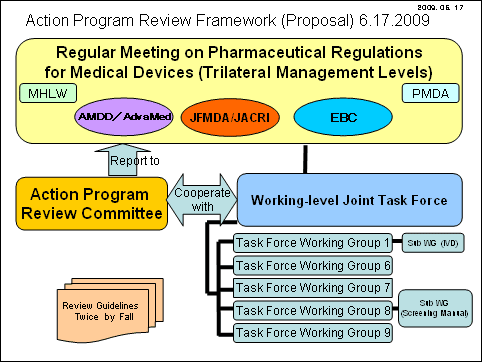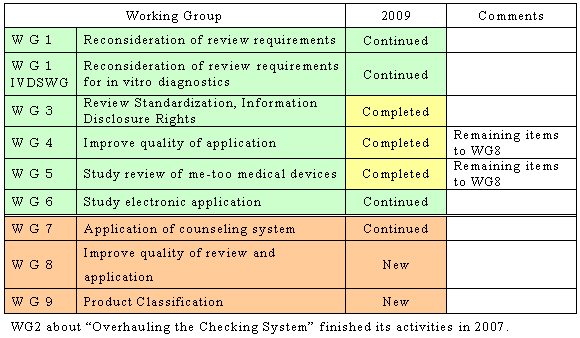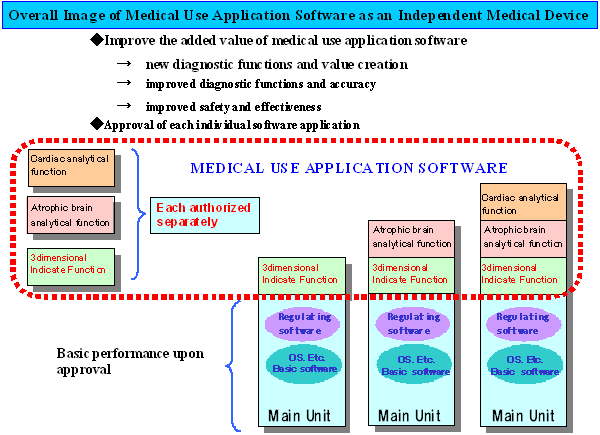 |
|
| January 2010 No. 63 | |
As noted in the explanation above of the Regular Meeting’s positioning, there are other meetings positioned below it. In this regard, the Review Director for the PMDA’s Office of Medical Devices presented information about the work of the Working-level Joint Task Force. He discussed the issues the Task Force has discussed so far and its future plans. He also explained the work (and the results) of each of the Working Groups. Accordingly, and in line with an explanation of the 2009 structure, we heard that Working Groups 3, 4, and 5 had completed their tasks and would end, and that three new Working Groups (7, 8, and 9) would be formed. It was also noted that a portion of the remaining tasks from Working Groups 4 and 5 would be carried over by Working Group 8.
3. Proposals and Requests from Various FieldsThe following industry-based opinions were reported with particular focus on the work of the JFMDA (Japan Federation of Medical Devices Associations), the AMDD (American Medical Devices and Diagnostics Manufacturers' Association), and the EBC (European Business Council). 1) Proposals continued from the last meeting(1)Abolishment of QMS(Quality Management System)on a product-by-product basisThe Revised PAL requires that each product pass a QMS Conformity Review in the process of gaining approval. However, because of issues such as the fact that product classification by class and laboratory differ inside and outside of Japan, the fact that those conducting the reviews must contend with complicated operations involving the PMDA, prefectural and city governments and Registered Certification Agencies of the PAL and because, from the manufacturer’s point of view, requiring each product to undergo a Conformity Review positions the QMS Conformity Review differently than before, there was a request that the Approval Process and the QMS Conformity Review be split up or separated. At the same time, in reference to product-by-product reviews, it was noted that manufacturers have both similar and different operations depending on each product. As far as similar operations are concerned, members expressed their intention to gain industry cooperation to discuss more reasonable ways of operating. (2)Transition to a registration system for approval of foreign manufacturing sitesConcerning the approval of foreign manufacturing sites, the Regular Informal Meeting has previously worked to make improvements by shortening the approval processing period from six to two-three months and having information on the approval process made available on the PMDA website (http://www.pmda.go.jp/operations/shonin/info/foreign/gaikokuseizounintei.html). At the same time, because of issues such as the fact that the approval application process for foreign manufacturers must be conducted by local agents in the Japanese language, the fact that there are multiple applications to be made, and the fact that it is difficult to get detailed information about other manufacturing sites that have been approved because they use agents, various operations-related problems remain. Also, since product renewals will need to be filed next year, and there is a high risk that those manufacturers who originally used an agent and who plan on discontinuing their product will fail to file the necessary paperwork, a proposal was made to transition to a registration system which excludes (1) manufacturers with only a name and address and (2) contracted sterilization services and OEM manufacturers. At the same time, regarding the system established to integrate approvals for domestic manufacturers, though attempts have been made to simplify information concerning structure and facilities, changing the system are difficult. In terms of operations, the explanation was limited to mention that discussions about operations are being considered by JFMDA’s Import WG. (3)Reexamining eligibility requirements for the Marketing Supervisor-GeneralThe eligibility requirements for marketing supervisor-generals who deal with medical devices requiring a high level of control and medical devices requiring control are very difficult with the candidate needing to have both academic credentials and work experience. The academic requirement is an obstacle for small-scale companies and the work experience requirement is an obstacle for new market entrants. There are numerous kinds of medical devices and, taking into consideration that knowledge and experience gained first hand is more effective than an academic credential, and that the Pharmaceutical Affairs Law, Enforcement Regulations says that a person can be approved if they have “knowledge and experience which is equivalent to or more than the approved level,” it was recommended that we reexamine the academic requirement through concrete operations such as training seminars for technical supervisors. In contrast, since post-marketing safety management does require a high level of knowledge, the present regulation requiring both academic credentials and work experience does not need to be changed. Since the wide variety of medical devices means that the knowledge needed about each device will vary, manufacturers should make specific proposals to be considered about each device. 2) New ProposalsInvestigative Committee about Medical Devices of High Medical NeedThough there have been discussions about the early introduction of medical devices in order to eliminate device lag, the discussions have been about individual matters such as device selection, review, and insurance coverage, and the early introduction of devices has remained difficult. For this reason, there is a request from medical practitioners that there be coherent project management of the process from review to insurance application. The “Investigative Committee about Medical Devices of High Medical Need” has been in existence since October, 2006 and, though its main purpose is to work to eliminate device drag, it is now taking up, as a sort of emergency matter, the issue of how to make available to Japanese patients medical devices of high medical need which are available overseas. The medical field was asked to list up devices of high medical need in order to have hearings to uncover the reasons behind the device lag. In discussion with the PMDA, ten items out of twenty-five were approved, seven are still under investigation and five have finished being investigated and are in the process of being approved. It was noted that there was early contact with the Economic Affairs Division, Health Policy Bureaus MHLW, regarding insurance matters and that these devices, compared with typical ones, are receiving priority attention . 4. Individual Opinions from OrganizationsEach organization shared individual opinions about their particular industry. The focus below, however, will be on JIRA’s opinion with information about other organizations simplified in bullet points. 1) JIRA’s OpinionIn terms of JIRA’s individual opinion, Mr. Kato, then Vice-chairman of JIRA, and attending the meeting as a committee member, presented two opinions based on prepared material. (1)The promotion of the “Medical Devicification” of Medical Use Application SoftwareThe following opinion was submitted concerning JIRA's long-standing point of view regarding the “The Promotion of the ‘Medical Devicification' of Medical Use Application Software.”
The medical use application software that JIRA proposes for authorization is software that is effective for medical treatment and can be installed individually in a computer and also individually merchandized. The software will have several purposes such as diagnostic imaging, 3 dimensional /4 dimensional image processing, instrument processing, and use as diagnostic support software. In response to this, we heard that the Government, including Health, Labour, and Welfare researchers, are working toward concrete goals and that JIRA will wait until this work is concluded before taking further action. Also, it was explained that JIRA is cooperating with JEITA (Japan Electronics and Information Technology Industries Association) with a desire to consolidate industry requests. (2)Concerning segmented warehouses used by medical device manufacturersWhereas under the old law, as a result of industry actions, deregulation permitted manufacturers to have separate warehouses, under the revised law, labeling, packaging and warehousing are treated as “manufacturing” activities; separate warehouses are no longer allowed and a Packaging Manufacturer License is required for anyone performing these tasks. This has made the manufacturing process cumbersome. Since a simple notice announced this policy, JIRA submitted an opinion concerning this on behalf of makers of large medical devices. In response, the government said they understood the request and asked that we inform them of the details of the actual situation on the ground. They explained that they would then consider what could be done. Based on this, JIRA’s Regulation and Safety Committee is presently working toward deregulation. 2) Opinions from members of other organizationsOther groups also shared each of their opinions. (1)JMED (Japan Medical Devices Manufacturers Association)-How to handle Pharmaceutical Affairs Law related to the stable supply of composite medical devices (including policies related to handling of pandemics). (2)JEITA (Japan Electronics and Information Technology Industries Association)-About guidelines for clinical research, especially non-significant risk for unapproved (per the Pharmaceutical Affairs Law) medical devices (3)EBC (European Business Council)-To mutually accept QMS (Manufacturing Quality Control System) audit results and promptly conclude a mutual recognition agreement (MRA) to accept Japanese Class II Medical Devices (controlled medical devices) and European Union Medical Device Directive (EU/MDD)Class IIa devices (4)JACRI (Japan Association of Clinical Reagents Industries)-Elimination of pre-approval inspections by the National Institute of Infectious Disease(continued proposal) 5. Summing UpThe Regular Informal Meeting was finally held after a lapse of a year and ten months. Though there is cause to be happy since the meeting will now convene regularly each year in June, one cannot help feel that with the significant changes to the positioning of the meeting, unlike in the past, there will be fewer opportunities or forums for government and industry to respond back and forth to each other in order to work toward reform. Industry members must look at this new positioning of the Regular Informal Meeting and, based on what looks effective, take another look at which opinions ought to be introduced for discussion. It was also pointed out during discussions that Notification 84, Supplementary Provisions (Article 2) of the Revised PAL (June 21, 2006) indicates that “once the law has been in effect for approximately five years, the Government will take into consideration the state of the law’s enforcement along with ways to regulate the revised medical law provisions to, if necessary, enact needed measures based on the results of investigations.” Since the Government is open to making changes as needed, we need to take advantage of this opportunity by working together to focus on promptly submitting solutions to the problems we see in the Revised PAL. Economy Division
|
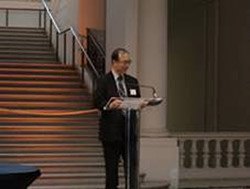 |
- "European directives 2007/27/EC coming into force and future of the European regulatory framework" - (EC)
- "COCIR strategic development and focus - (COCIR)
- "GHTF: European strategic views" - (EC)
(1) Revised MDD
Progress on the revised MDD 2007/47/EC was updated. EU member countries were to adopt it into their national laws by the end of December 2008. But, the 13 countries have not yet adopted it into their national laws. When companies deliver their products to EU after March 21, 2010, they will be required to comply with the revised MDD. The main points of revision are as follows. They are conformity to Machinery Directive, clear statement that software shall be classified as a medical device, clinical evaluations, conformity assessment (clear statement of assessment of technical documents), and changes of essential requirements, etc.
(2) Recast (the revision of structural problems of MDD)
The structural problems of MDD still remain unsolved. MDD needs to address competition and innovation, to address both the national and international markets, and to improve transparency. The new approach also needs to be improved. These matters need revision of legal framework in a more systematic manner. For these purposes, the recast was proposed. About 200 comments were received. So, it will take some more time to debate the recast.
(3) The COCIR' activities and the issues to be addressed about the EU laws
Short term
| - | Collaboration with the European Commission about the revised MDD, and drafting of NB-MED(Notified Bodies Medical Devices) and an interpretation document. (NB-MED/2.2/Rec 5 and Implementation of Directive 2007/47/EC) |
| - | Solution of the discrepancy between MDD and national laws. |
- Registration request of each country (Italy and France)
- Discrepancy between MDD and national laws: A vigilance system, clinical evaluations, etc.
- Solution of the deviation issues among each member countries adopting the EURATOM directive (EURATOM directive that is related with ionization radiation) into their national laws.
- Working in cooperation with the European Commission.
Medium term
- Promotion of the recast of MDD- Support industries to adopt state-of-the-art technologies.
- Collaboration with the administrative authorities, and drafting of the guidance documents, etc.
Long term
- Promotion of international harmonization with regard to the regulation issues.- GHTF, AHWP(Asian Harmonization Working Party), STED(Summary Technical Document), UDI(Unique Device Identification), GMDN(Global Medical Device Nomenclature)
| - | Participation in SC(Steering Committee), SG(Study Group), etc. of GHTF |
| - | Collaboration with the European Commission and promotion of the EU model. |
| - | Europe has plural directives, so their essential requirements sometimes contradict mutually and lack harmonization. Ideally, the requirements of each of the following directives should be met with a single directive, without referring to other directives. |
- MDD, Machinery directive, PPE (Personal Protective Equipment ), EURATOM(Europian Atomic Energy Community), EMF(Electro Magnetic Field) (Protection of workers), RoHS, WEEE, and EuP
In addition to the above-mentioned matter, it was explained how EU is involved in GHTF. In GHTF, EU is represented by the European Commission, the member country delegates, and the industry associations including COCIR.
2. Standardization policy workshop
Each affiliate delegate performed the following presentation.- "Reform of European standardization process -EXPRESS Panel” - (EC)
- "Strategic directions of ICT standardization" - (EC)
- "How IEC is addressing European needs" - (IEC WG)
- "COCIR standardization policy" - (COCIR)
Standards are indispensable tools that are required for the international trade, and for design of medical devices related to patient's safety. The European Commission aims at the reform of European standardization system and the promotion of standardization of ICT (Information and Communication Technology). For this purpose, the Commission has organized an "EXPRESS team" to strategically address this issue. The Commission is scheduled to publish the legal package in the middle of 2010. COCIR collaborates closely with CENELEC, IEC and ISO to support standardization. The COCIR’S action policy about standardization issues is established firmly.
3. China workshop
Each affiliate delegate performed the following presentation.- "China's health reform and its implications in MD industry" - (COCIR-China)
- "Regulatory framework for medical device in China: Overview and recent developments" - (COCIR)
- "EU-China Medical Devices Expert Roundtable (MDER) - Opportunities seen from the European Commission" - (EC)
(1) China's healthcare reform
China's medical system has the following problems.- The medical service cannot be received easily. Because the medicalexpense has increased drastically.
- According as people gain more income, they increasingly demand the advanced medical service.
- At present, one retired worker is supported by 3.65 people. By 2030, however, one retired worker will have to be supported by only two peoplepersons, because of the only-one-child policy and aging society.
- The increase in an unhealthy life style has resulted in diversification of the disease patterns. (heart disease, chronic disease, etc.)
- The incidence rate of an infection disease has increased.
With these matters being considered as a background, China announced officially the healthcare reform in April 2009. By 2011, 850 billion yuan will be spent from national budget to reform the medical insurance systems, to improve hospital facilities, and to take other actions. In the 2009 fiscal year, 118.01 billion yuan will be spent, which is a 38.2% increase compared with 2008. It is said that the installed medical devices need to be upgraded at 80% of clinics and 70% of hospitals.
(2) Activities of COCIR
- Sending of the comments to a 2008 healthcare reform draft plan.
- Positive exchange with the associations of EU, the U.S., and China.
- Positive exchange with Chinese administrative authorities.
- Information exchange with other industrial associations.
- Putting the healthcare reform in the agenda for the round table between EU and China, and ensuring that the EU authorities have more interest in this issue.
(3) Chinese medical device requlations.
- Explanation of the overview of Chinese laws related to medical device.
- Publication of the plans for the revised edition of Chinese Medical Device Regulation Rule No. 276. It is not known when the rule will be published.
- Publication of the plans for the revised Registration Regulation Rule. It is not known when the rule will be published. COCIR is preparing to collect public comments under the name of EUCCC in cooperation with Eucomed.
- December 2008: SFDA published "The defect report of medical device and the interim countermeasures about reevaluation".
- March 2009: SFDA and Bejing Institute of Measurement and Testing (BIMT) cosponsored and started "The survey project for EU medical device standard system".
- April 2009: The draft issued by AQSIQ about recall of defective products.
(4) Information exchange about the medical device of China and EU (MDER program)
China is a large market place for COCIR. But, it is necessary to comply with all the Chinese laws, such as pre-market approval, environment laws, price control, public procurement. COCIR cooperates with the European Commission, promotes GHTF documents, supports China, which dispatches a representative as the chair of AHWP, and supports harmonization of laws. Moreover, COCIR sponsors the long-term program for law dialog between EU and China. This program is called MDER (MD Expert Roundtable), and promotes the EU law systems to China. The aim is to actively influence changes of the Chinese laws.- MDER started from November 2007. Six meetings have already been held.
- Promotion by the approach by six WGs.
- Conformity assessment containing QMS.
- The third-party approval including the product certification and type test.
- Adoption of international standards.
- Market survey. (Traceability, defect report, etc.)
- Renewal of MD (Refurbishment).
- The introduction of risk management.
The next MDER is scheduled to be held in October with Chinese SFDA, AQSIA and CNCA/SAC.
4. Environment policy workshop
Each affiliate delegate performed the following presentation.- "EcoDesign for Energy using Products, requirements, solutions and opportunities"- (EC)
- "EU Sustainable Consumption and Production (SCP)/ Sustainable Industry Policy (SIP) Action Plan - Regulatory update and insight"- (EC)
- "COCIR green initiatives to advance healthcare" - (COCIR)
The effective eco-management adopts the continuous and innovative process, increases the product value, and ensures the optimal use of resources such as raw materials, etc. and also makes the effects on the environment less. Moreover, the EU parliament determined in December 2008 the action plan about the environment-friendly Sustainable Consumption and Production (SCP). This increased the importance of eco-management for products.
(1) Results of COCIR's activities for environment issues
- European Commission adopted COCIR's proposal, and exempted medical devices from RoHS.
- A BOM check database was built with the data collected from the supply chain. It is now possible to meet the legal requirements of RoHS, WEEE, and REACH. Manufacturers and supply chains can meet these legal requirements by using a single BOM check, and can reduce the cost.(Refer to www.BOMcheck.net)
- COCIR created the REACH guidance document. Thus, comprehensive data collection is now easy.
- COCIR obtained permission from the European Commission that the voluntary regulation is allowable for medical devices to meet the EuP directive. As a result, companies need not bear such design cost that is additional and unfeasible.
- COCIR contributed to the adoption of the environment standard IEC 60601-1-9 , thus decreasing the time and cost.
5. Sustainability and eHealth workshop
Each affiliate delegate performed the following presentation.- "Introduction on need for transformation in healthcare to meet the demographic change" - (COCIR)
- "Why is the sustainability of healthcare so important to industry" - (COCIR)
- "Lessons learned from more than 10 years of discussion about eHealth" - (COCIR)
- "Strategy of the Commission to foster the implementation of eHealth" - (EC)
- "How to drive a shared eHealth infrastructure and bring all stakeholders on board of national transformation? The example of Estonia" - (Estonia eHealth Foundation)
- "The role of doctors in those strategies" - (Standing Committee of European Doctors)
- "What is the role of the health insurances" - (Association Internationale de la Mutualite)
The health care is one of the important economic factors in EU. In order to enable the EU member countries to build a sustainable health care system, COCIR released in 2008 the following action plans.
1) Vision: A sustainable health care system shall be built by a large majority of EU member countries by 2020.
2) Missions: Making effort to improve the five prioritized areas.
- Implementation of the best practice
- Prevention of disease
- Information technology
- Rapid adoption of medical technology
- Redemption system
In addition to the above-mentioned matters, the ten recomendations to promote eHealth (electronization of health care system) are made to call for actions and dialogues.
6. Good Refurbishment Process Workshop
Each affiliate delegate performed the following presentation.- "Global picture on refurbishment" - (COCIR)
- "COCIR efforts introducing refurbishment in China" - (GEHC)
- "COCIR strategy & Good Refurbishment Practice(GRP) Outline" - (COCIR)
A refurbished medical device is an important business sector for COCIR member companies. In order to make a refurbished medical device as effective and safe as a new device, COCIR created in 2007 the first edition of guideline, which is called GRP (Good Refurbishment Practice) green paper.
International Division
Report on attendance at APEC LSIF Steering Assembly
LSIF (Life Science Innovation Forum) was held in Los Cabos, Mexico in October 2002 in conjunction with APEC (note) conference. The assembly announced the new technology in life science, the project results, etc. The aim is to harmonize the regulations among APEC member economies and to rapidly commercialize the new technology.
(note)
APEC(Asia-Pacific Economic Cooperation), is the premier forum for facilitating economic growth, cooperation, trade and investment in the Asia-Pacific region .
APEC has 21 members -- referred to as "Member Economies" -- which account for approximately 40.5% of the world's population, approximately 54.2% of world GDP and about 43.7% of world trade.
APEC's 21 Member Economies are Australia; Brunei Darussalam; Canada; Chile; People's Republic of China; Hong Kong, China; Indonesia; Japan; Republic of Korea; Malaysia; Mexico; New Zealand; Papua New Guinea; Peru; The Republic of the Philippines; The Russian Federation; Singapore; Chinese Taipei; Thailand; United States of America; and Viet Nam.
LSIF simulated the drug GCP(Good Clinical Practice), counterfeit countermeasures, GCP audit, GMP(Good Manufacturing Practice) and other GHTF activities, held the workshop about the harmonization of the regulations and continued the activities until 2007. The 6th LSIF was held in Lima, South America in August 2009. This motivated the support of foundation of AHC (APEC Harmonization Center), and the foundation of RHSC (Regulatory Harmonization Steering Committee) for the purpose of harmonizing the regulations among APEC members and strengthening the responsiveness to regulations. In June 2009, the 1st RHSC was held in Seoul, Korea and resulted in foundation of AHC . At the same time, the workshop about MRCT (Multi Regional Clinical Trial) was also held.
Japan was represented by JIRA at the 2nd RHSC held in August 2009.
RHSC of APEC was held in Singapore during the LSIF period (August 2-4, 2009). RHSC was founded at the same time when AHC Education Center AHC of APEC was established in Korea in June 2009, and the first meeting was held.
Under APEC's strategy in LSIF, RHSC was founded for the purpose of harmonizing the regulations among APEC members and strengthening the responsiveness to regulations.
RHSC consists of administrative authorities and industries (for drug and medical device), as well as academic societies, among APEC members. The administrative authorities come form China, Taiwan, Korea, Peru, Thailand and the U.S. The chairperson comes from the Canadian authority.
This meeting confirmed the terms of reference and membership, and discussed the relation with AHC Education Center and its operation rule.
About AHC Educational Center:
In 2008, AHC discussed its foundation at LISF, and in June 2009, its foundation was decided at the 1st RHSC held in Seoul. The director is KFDA, and the headquarters are located in Seoul. The position of the Center in the organization is ambiguous in relation to RHSC which was founded at the same time as LSIF. But, the Center is to report to RHSC about experiments including feasibility. The advisory board is to be formed.
The figure shows the relation between the Center and LSIF, and the relation between LSIF and RHSC. One of the activities of APEC LSIF is the educational program for the region. This program and its content of education are investigated by AHC as drug/medical device in the practical aspect. The figure shows the relation between AHC and its Advisory Board (AB).
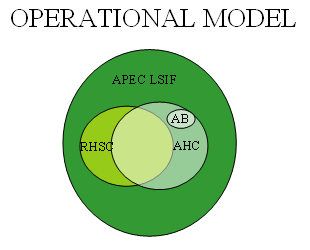 |
(Quoted from RHSC chairperson's slide) |
Moreover, RHSC approved the following projects and submitted them to the superior organization for approval.
- The continuous training of "best regulatory practices" by Taiwan
- The APEC fund by BIO(Bio Technology Industry Organization) of Korea will not be used.
- The workshop "Biosimilars workshop" in September 16-17, 2009 in Korea
- "Stem Cell Product QA/QC" seminar by Thailand
- "Multi-Regional Clinical Trials (MRCT)" will be held by Thailand in 2010.
The next RHSC Assembly is scheduled to be held in the spring of 2010.
